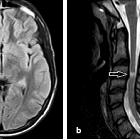Fluid attenuated inversion recovery
Fluid attenuated inversion recovery (FLAIR) is a special inversion recovery sequence with a long inversion time. This removes signal from the cerebrospinal fluid in the resulting images. Brain tissue on FLAIR images appears similar to T2 weighted images with grey matter brighter than white matter but CSF is dark instead of bright.
Physics
To null the signal from fluid, the inversion time (TI) of the FLAIR pulse sequence is adjusted such that at equilibrium there is no net transverse magnetization of fluid.
Clinical use
The FLAIR sequence is part of almost all protocols for imaging the brain, particularly useful in the detection of subtle changes at the periphery of the hemispheres and in the periventricular region close to CSF.
The usefulness of FLAIR sequences has been evaluated in many diseases of the central nervous system such as :
Post-contrast FLAIR images have been included in protocols to assess leptomeningeal diseases, such as meningitis .
Siehe auch:
- Subarachnoidalblutung
- MR Pulse Sequenzen - Abkürzungen
- Encephalomyelitis disseminata
- STIR - short tau inversion recovery
- infarction
- TIRM - turbo inversion recovery magnitude
und weiter:

 Assoziationen und Differentialdiagnosen zu Fluid-attenuated inversion recovery (FLAIR):
Assoziationen und Differentialdiagnosen zu Fluid-attenuated inversion recovery (FLAIR):


